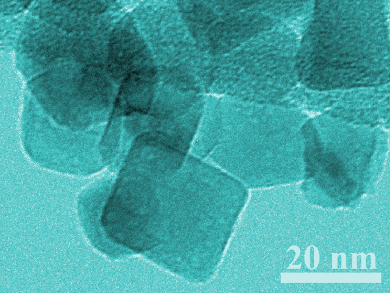Photocatalytic hydrogen production can be used to provide sustainable, clean fuel. For an efficient process, it is important to promote the use of visible light by the photocatalyst, as well as the effective separation and transmission of the generated charge carriers.
Qingmao Feng, Baojiang Jiang, and colleagues, Heilongjiang University, Harbin, China, have synthesized Pt-decorated porous TiO2 nanocube composites (pictured). The team first prepared TiO2 nanocubes by adding HF to TiCl4 in ethylene glycol, followed by a hydrothermal reaction and a calcination in air at 500 °C. Platinum was deposited on the nanocubes using a photodeposition method with chloroplatinic acid. The Pt-decorated nanocubes were then used for photocatalytic H2 generation.
The team found that the surface plasmon resonance (SPR) effect of Pt enhances the photocatalytic hydrogen evolution performance. The Pt-decorated nanocubes have a solar‐driven photocatalytic hydrogen evolution rate that is about 37 times higher than that of unmodified TiO2 nanocubes. According to the researchers, the strong interaction between the Pt nanoparticles and the catalyst improve the electron-hole separation efficiency and visible-light photocatalytic efficiency.
- In-situ Platinum Plasmon Resonance Effect Prompt Titanium Dioxide Nanocube Photocatalytic Hydrogen Evolution,
Shan Hu, Panzhe Qiao, Yunqi Fu, Fuxiang Li, Xudong Xiao, Chen Zhao, Qingmao Feng, Baojiang Jiang,
Chem. Asian J. 2019.
https://doi.org/10.1002/asia.201801893




